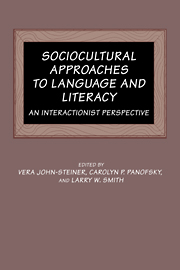Book contents
- Frontmatter
- Contents
- List of contributors
- 1 Introduction
- Part 1 Context
- Part II Mediational processes
- 5 Nonverbal factors in the interpsychic to intrapsychic internalization of objects
- 6 An ecological approach to the emergence of the lexicon: Socializing attention
- 7 Learning how to explain: The effects of mother's language on the child
- 8 Developing the representational functions of language: The role of parent–child book-reading activity
- 9 The implications of Vygotskian theory for the development of home-school programs: A focus on storybook reading
- 10 Vygotsky in the classroom: An interactionist literacy framework in mathematics
- Part III Functional systems
- Author index
- Subject index
9 - The implications of Vygotskian theory for the development of home-school programs: A focus on storybook reading
Published online by Cambridge University Press: 05 November 2011
- Frontmatter
- Contents
- List of contributors
- 1 Introduction
- Part 1 Context
- Part II Mediational processes
- 5 Nonverbal factors in the interpsychic to intrapsychic internalization of objects
- 6 An ecological approach to the emergence of the lexicon: Socializing attention
- 7 Learning how to explain: The effects of mother's language on the child
- 8 Developing the representational functions of language: The role of parent–child book-reading activity
- 9 The implications of Vygotskian theory for the development of home-school programs: A focus on storybook reading
- 10 Vygotsky in the classroom: An interactionist literacy framework in mathematics
- Part III Functional systems
- Author index
- Subject index
Summary
How are programs organized to assist low-income parents to prepare their children for school? Surprisingly, we know little about this question, particularly as it applies to the theoretical principles researchers and educators have used to develop home-school programs. This question becomes increasingly important as more attention is directed toward the education of children who traditionally do not fare well in school (see Garcia, Pearson, & Jimenez, 1990). Yet book-reading programs continue to be developed for low-income parents and children with scant descriptions of the theoretical principles employed.
One aspect of Vygotsky's work (1962, 1978; Wertsch, 1984), the zone of proximal development, focuses on what adults – parents or teachers – do to stretch children's learning. Another aspect suggests that learning must be socially situated, and that for learners to move through the zone of proximal development they must internalize what they have learned through social interaction. In order to do this, learners need to be given the opportunity actively to construct and interpret academic tasks. While Vygotsky did not detail how more capable peers or adults were supposed to help stretch children's learning in this fashion, other researchers influenced by Vygotsky have used his theory to experiment with scaffolding, guided participation, and reciprocal teaching (Collins, Brown, & Newman, 1989; Palinscar & Brown, 1984; Rogoff, 1984). Yet, to our knowledge, few researchers, if any, have used the different aspects of Vygotsky's theoretical model, and the practical suggestions of other researchers influenced by Vygotsky, to stretch parents' learning and, especially, parents' learning of bookreading strategies (Edwards, 1991).
- Type
- Chapter
- Information
- Sociocultural Approaches to Language and LiteracyAn Interactionist Perspective, pp. 243 - 264Publisher: Cambridge University PressPrint publication year: 1994
- 2
- Cited by



